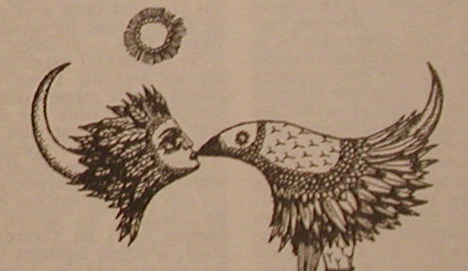In the early 1950s in Paris before the 1957 foundation of the Situationist International, in a petri dish populated by old- and new-guard Lettrists, neo-Surrealists, and everything in between, a flurry of new (or simply reparceled) ideas, concepts, and practices first saw the light: dérive, détournement, psychogeography, unitary urbanism, the “surinternational mental rendezvous,” and the like.
It is from this time and context that a certain fragment from the W Cache appears to reach us. Amid many dissident-Surrealist, proto-Situationist groups, the members of the small cenacle around the Ukrainian-French Olha Espy were all recent emigrés from East and Central Europe. The document in question was almost certainly created and put into circulation by members of the Espy cenacle (whose relations with the Order of the Third Bird remain uncertain), and is without question a “protocol card” of the type still in use among associates of the Order. Dogeared and stained, it is covered with annotations in various handwritings, inks, and languages (French, Polish, Swedish, Hungarian), suggesting that it has passed through many sets of hands and was frequently reused.
An enormously valuable document, it is also unique, being one of our only evidences of a protocol intended for practitioners separated widely in space. A typical action – always in an urban setting – might for example have included practitioners located in Boston, Marseille, Frankfurt, Izmir, and so forth. It seems that participants only needed to decide in advance upon timing (phases were set to begin and end based on Paris hours), and to assure that each participant had beforehand received a sealed envelope containing instructions, to be opened during the action. The phases of the protocol could not be more standard, but their implementation could not be more idiosyncratic.
-The phase of encounter lasts from one to three hours. During this phase, a group of two practitioners (there can be no more nor less than two in each location) wanders freely in the urban space in which it finds itself. By a given hour – for example, 3 in the afternoon – the duo is to have chosen its “starting location.”
-The phase of attending begins when the duo opens an envelope containing instructions or rather, directions. From its chosen “starting location,” it is directed (for example) to take the first right, then to take the third left, then the second right; to walk straight ahead until seeing (for example) something large and yellow, and turn to face it; then to turn 75 degrees. Upon completing these instructions, the duo must consult its immediate surroundings and field of awareness in order to locate the work. The journey to the work, and the silent process by which the two practitioners agree upon the identity of the work, are considered to be fundamental parts of the work.

-The phase of negating comprises an additional series of instructions for the completion of small and modest tasks in the vicinity of the work, often involving passersby. One might easily compare these to the creation of what would later be called “situations,” but on a smaller and more intimate scale.
-The phase of realizing appears to be entirely freeform. The practitioners understand that their realization may be private and ephemeral, or may be public and potentially scandalous, with profound repercussions. The scale of its ambition is not fixed in advance, but neither is it limited to any degree.
–Colloquy, between the small groups separated across the globe, is supposed to take place by “telepathy.” We can presume that in a cultural-political milieu generally hostile to all manifestations of romantic mysticism and occult yearning, this word was not to be taken literally, but we have not been able to reconstruct its practical mechanism. Perhaps it was as simple as an exchange of reports by post.
It would be interesting to see if this particular protocol can remain viable today, outside its natural postwar Parisian environment.
The Secretary Locotenant of the Order has passed on the following document from the Secretary’s private collection: a detail from a very suggestive drawing made by group-leader Olha Espy herself.

